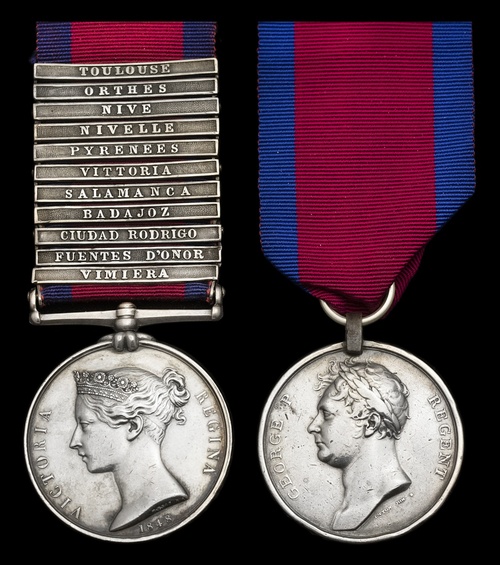
Auction: 24003 - Orders, Decorations and Medals
Lot: 80
Pair: Serjeant D. McDonald, 52nd (Oxfordshire) Regiment of Foot
Military General Service 1793-1814, 11 clasps, Vimiera, Fuentes D'Onor, Ciudad Rodrigo, Badajoz, Salamanca, Vittoria, Pyrenees, Nivelle, Nive, Orthes, Toulouse (D. McDonald, Serjt 52nd Foot.); Waterloo 1815 (Serj. Donald M'Donald, 1st Batt. 52nd Reg. Foot.), the first very fine, the second with heavy edge bruising and a number of edge knocks, fine (2)
Donald McDonald is confirmed upon the roll with entitlement to these medals and clasps.
The 52nd (Oxfordshire) Regiment of Foot was amongst the largest and most heavily engaged units in the Peninsular Campaign and later took a central role in the action at the Battle of Waterloo. The regiment was present at numerous battles, and particularly distinguished itself for its gallant conduct and bravery at select engagements.
Peninsular War
At the Siege of Ciudad Rodrigo in January 1812, for which McDonald was present, the 52nd Foot was in Colonel John Colborne's Light Division. They stormed and successfully captured the San Francisco redoubt, taking the enemy by surprise. In the immediate aftermath of the capture, they began digging trenches to prepare for the main assault, with all work being completed under the stress of enemy fire. Upon the completion of the siege works, Wellington ordered the immediate start of the siege due to the threat of French Marshal Marmont's advancing troops. Colborne's Light Division formed the column which mounted the escalade against the San Francisco Convent, with Lieutenant John Gurwood of the 52nd Foot leading the men of the Forlorn Hope, followed by 300 stormers. The night time assault was successful, with the fort being taken in under half an hour.
The 52nd Foot, with McDonald present, was soon again involved in another siege the following March at Badajoz, which was amongst the bloodiest engagements of the campaign. The Light Division dug trenches and installed batteries in mid-March in preparation for the siege, which was ordered on 6 April. Forlorn Hope columns from the Light Division and the Fourth Division were the first to advance of the bastions of La Trinidad and Santa Maria. The French deployed a mine and subjected the British troops to heavy fire as they prepared to breach the fortress, resulting in many casualties and an order to withdraw. By dawn the next day, the Light Division had lost over 700 men, 40% of their number, with the British suffering 5000 dead to successfully capture the Badajoz fortress.
In the aftermath of their intense involvement in the sieges of Ciudad Rodrigo, Badajoz, and later St. Sebastian, the 52nd Regiment of Foot issued the Forlorn Hope medal to members of the regiment who participated in one of the sieges. Given that McDonald was present for two of these actions, he likely would have been a recipient.
The 52nd Foot was engaged at many more battles over the course of the campaign, often featuring prominently in the action. At the Battle of Vittoria on 21 June 1813, the 52nd Foot was in the 2nd Brigade Light Division commanded by Major-General Charles Alten and held the centre of the allied line. The 52nd was further engaged in gallant action during the Battle of Orthes on 27 February 1814, where they led an uphill assault under heavy fire. Ordered by Wellington to drive a wedge into the French defence, Colborne led the unit through marshlands and up the ridge of the Luc knoll, causing French commander Eloi Taupin's division to retreat from the hill. The 52nd Foot's advance was later described by Lieutenant-General Sir Harry Smith as the most majestic he had ever seen.
Waterloo
Ahead of Napoleon's escape from Elba, the 1st Battalion, 52nd Foot was sent to America to fight in the ongoing War of 1812. However, upon learning of their need in Europe they returned and disembarked at Belgium to join Lieutenant-General Sir Roland Hill's II Corps in the 3rd Brigade, 2nd Division. McDonald is recorded as having served in Captain Love's Company.
The largest battalion present at Waterloo, the 1st Battalion 52nd Foot was initially held in reserve with the 2nd Division before being positioned centre-left, forming into squares to repel attacks of the French cavalry. Ensign William Leeke of the 52nd Foot, who carried the unit's colours during the battle, later said of the regiment's experience:
'The old officers, who had served during the whole of the Peninsular War, stated that they were never exposed to such a cannonade as the 52nd squares had to undergo on this occasion for 2½ hours from French artillery ½ mile to the front'.
Towards the end of the day, the 52nd gained the distinction of having been the regiment that broke Napoleon's Imperial Guard, which had begun an attack on the weakened British centre. Colonel Colborne, commander of the 52nd Foot in the 2nd Division, made the decisive action of his own initiative to bring his troops forward. They formed into a line and fired a devastating series of volleys, after which they charged and caused the Imperial Guard to retreat, causing ripples of panic through the rest of the French forces. Some say this engagement of the 52nd even turned the tide of the battle itself. William Hay, a nearby Light Dragoon observer, remarked:
'So well-directed a fire was poured in, that down the bank the Frenchmen fell and, I may say, the battle of Waterloo was gained'.
After emerging victorious at the Battle of Waterloo, the 52nd Foot marched into Paris as part of the army of occupation and were stationed in France until 1818 when they finally returned home to England. McDonald was later discharged upon the expiration of his length of service; sold together with copied research.
Subject to 20% VAT on Buyer’s Premium. For more information please view Terms and Conditions for Buyers.
Sold for
£7,000
Starting price
£2500




